Classic American Motorcycles
The roar of an engine, the wind in your face, and the unmistakable style that turns heads—American classic motorcycles have an enduring charm that transcends time. In this journey through the annals of motorcycle history, we explore the iconic names that have become legends on the open road.
American classic motorcycles embody a rich craftsmanship, design, and cultural significance legacy. Each brand tells a story of innovation, style, and the spirit of the open road.
Table of Contents
Steaming into History ( 1869- 1900 )

The journey of self-propelled two-wheeled machines in the United States can be traced back to the innovative efforts of individuals like Sylvester Hayward Roper. Roper and French partners Pierre Michaux and Louis Guillaume Perreaux from Paris embarked on a journey to mark the inception of motorized two-wheelers on American soil. The exact date of their completion remains uncertain, but their creation made its public debut in 1869.
A notable milestone occurred in December 1884 when Lucius D. Copeland, hailing from Phoenix, Arizona, showcased his steam-powered bicycle at a San Francisco exposition. This demonstration marked a significant moment in the evolution of self-propelled two-wheelers, providing a glimpse into the potential of steam power for personal transportation.
Fast forward to the turn of the 20th century, and we encounter the endeavours of George Holley from Bradford, Pennsylvania. In the year 1900, Holley crafted his inaugural Holley Motorcycle. Reflecting the trends of the time, this early motorcycle, like many others, featured a push-start mechanism. These pioneers, driven by curiosity and a spirit of innovation, laid the groundwork for the motorcycling legacy that would unfold in the years to come.
As these visionaries experimented with steam power and explored novel designs, they set the stage for the broader narrative of American motorcycling. The early attempts and public showcases were crucial steps in transitioning from traditional pedal-powered bicycles to the thrilling realm of motorized two-wheelers.
ACE
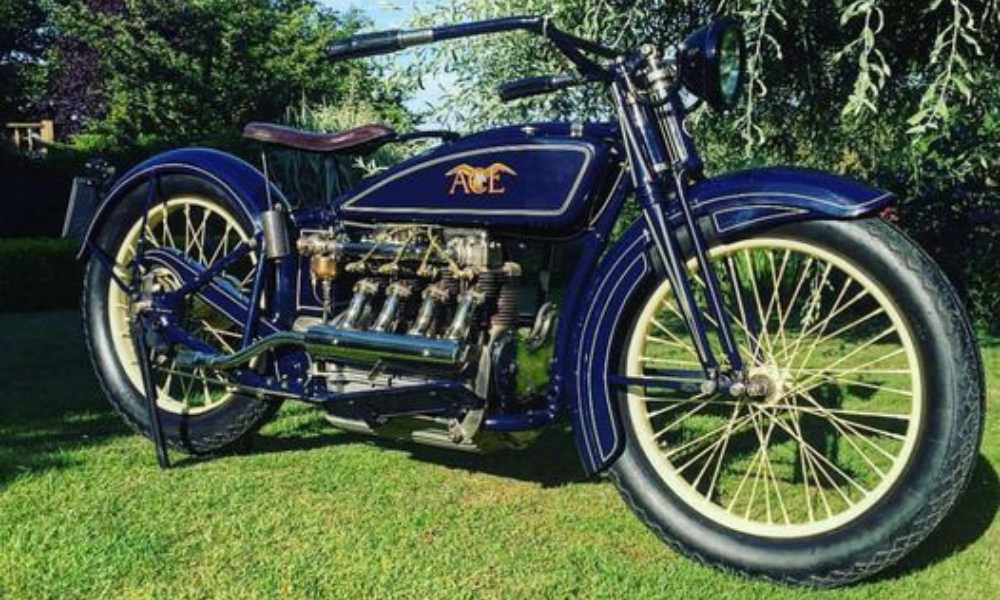
ACE motorcycles stand out as a testament to grace and power in the vibrant tapestry of motorcycle history. To make its mark on the history of two-wheeled excellence, William Henderson founded ACE in Philadelphia in 1919. Unfortunately, Henderson’s life was cut short in a motorcycle accident in 1922, but the company persevered under the design leadership of Arthur Lemon.
The early ACE motorcycles were characterised by their innovative intel-over-exhaust engine design and aluminium pistons—a cutting-edge choice. The ACE lineup, ranging from the ACE 100 to the ACE 1200, showcases a spectrum of motorcycles that have left an indelible mark on enthusiasts. Each model within this series boasts distinctive features, setting it apart from its counterparts and contributing to ACE’s reputation for excellence.
However, the company faced financial difficulties, a common challenge in the evolving landscape of the motorcycle industry during that era. In 1927, facing financial constraints, ACE found itself in the hands of the Indian Motorcycle Company. The acquisition led to a rebranding, and the machines were now named “Indian Ace.” This strategic move allowed ACE’s legacy to endure under the umbrella of a well-established and financially stable company.
The story of ACE motorcycles continued to unfold within the Indian Motorcycle Company. Over time, the Indian Ace models evolved, eventually transforming into the iconic Indian Fours. This evolution marked a seamless transition, preserving the elegance and power that had defined ACE motorcycles from the beginning.
Cleveland

Cleveland is one of the many short-lived yet impactful manufacturers in the rich tapestry of American motorcycle history. Operating briefly between 1915 and 1929, Cleveland motorcycles made a mark that transcended their relatively short existence. Notably, in 1922, Cleveland took over Reading Standard, adding an intriguing chapter to its story.
Cleveland motorcycles emerged during a dynamic period in American history, sandwiched between the end of World War I and the onset of the Great Depression. This era saw a surge in motorcycle enthusiasm and innovation, with numerous manufacturers vying for a slice of the growing market. Cleveland found its place among these contenders, establishing itself as a name to be reckoned with in the industry.
Cleveland motorcycles were renowned for their sound design, a hallmark that characterised their offerings from the start. The journey began with a modest 269cc two-stroke engine, showcasing the company’s commitment to engineering excellence. As the years progressed, Cleveland didn’t just keep pace; it pushed the boundaries of motorcycle design.
In 1924, Cleveland introduced a 347cc single-cylinder engine featuring the innovative intel-over-exhaust design. This marked a significant step forward in the company’s quest for performance and innovation. Not content with resting on their laurels, Cleveland continued to raise the bar, unveiling a powerful 746cc in-line four-cylinder engine—a testament to their commitment to pushing the limits of motorcycle engineering.
The promising trajectory of Cleveland motorcycles took an unfortunate turn with the Wall Street Crash of 1929. Despite the undeniable quality of their products, the economic fallout from this catastrophic event forced the company to shut its doors. The financial strain became insurmountable, marking the end of an era for Cleveland motorcycles.
Crocker
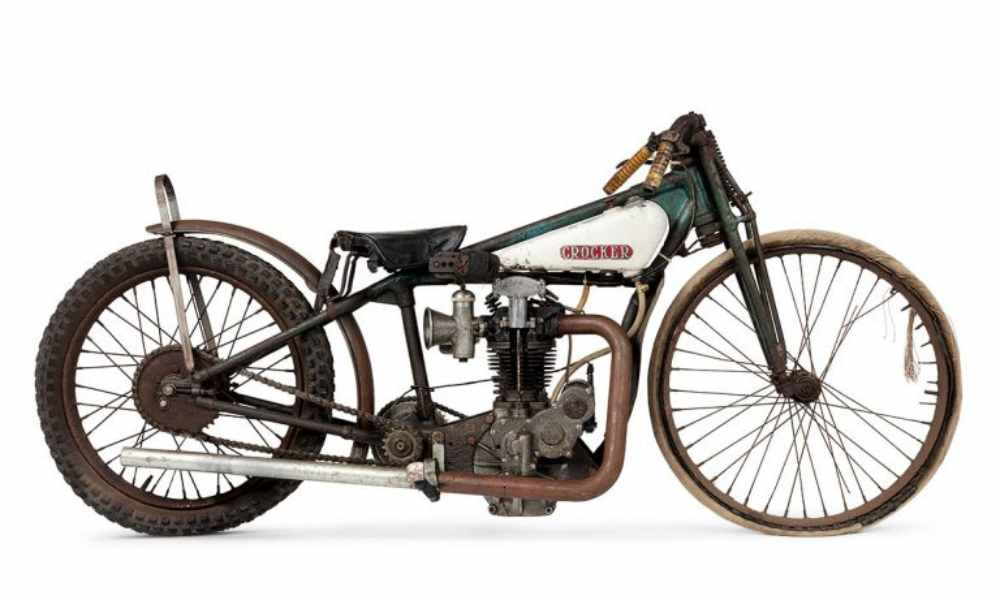
Albert Crocker, initially a Los Angeles Indian dealer deeply immersed in the motorcycle business, transcended his role and embarked on a journey that would see the birth of the iconic Crocker motorcycles. Shifting from dealership to manufacturing, Crocker created a brand that would leave an indelible mark in the motorcycle world.
Albert Crocker’s foray into motorcycle manufacturing was pivotal in the industry. As a dealer, he had a front-row seat to the evolving landscape of motorcycles. Sensing an opportunity to bring his vision to life, Crocker transitioned from selling to crafting, giving birth to his line of motorcycles.
Crocker didn’t just assemble motorcycles; he produced his engines. This marked a significant departure from the norm, showcasing Crocker’s dedication to crafting machines that stood out from the crowd. Notably, his involvement in Speedway saw the creation of chain-drive machines, a testament to his versatility and commitment to innovation.
In 1936, Crocker Motorcycles made a groundbreaking move by introducing their first overhead valve 61 cubic inch V-twin motorcycle. At this pivotal moment, they defined the brand’s commitment to pushing the boundaries of performance and design. The introduction of overhead valves represented a leap forward in engineering, setting Crocker motorcycles apart from their peers.
Crocker motorcycles didn’t merely stay within traditional biking; they found their way into the realms of bobbers and choppers. With their distinctive short rear fenders and scalloped paint schemes, Crocker motorcycles became not just a mode of transportation but a statement of style and individuality.
Cyclone

In the annals of motorcycle history, the Cyclone, produced for a brief but impactful four years by the Joerns Motor Company, is a testament to technological innovation and racing prowess. With its introduction in 1913, the Cyclone V-twin was not just ahead of its time; it was the most technologically advanced motorcycle of its era.
The Cyclone V-twin, displacing 996cc, showcased revolutionary features that set it apart as a technological marvel. Introduced in an era where innovation was taking centre stage, the Cyclone boasted overhead camshafts—a part that wasn’t commonplace in motorcycles. This technological leap signalled the Cyclone as a harbinger of the future.
What truly made the Cyclone stand out was its meticulous engineering. The roller-bearing-mounted crankshaft and connecting rods exemplified precision and durability. A bevel-driven camshaft added to the sophistication, showcasing the company’s commitment to pushing the boundaries of design. The forged steel flywheels, with a distinctive spoked design, were a testament to the Cyclone’s commitment to performance and aesthetic appeal.
The performance of the Cyclone was nothing short of exceptional for its time. The Yellow Cyclone racers, in particular, etched their names into the annals of racing history by clinching numerous victories. The Yellow Cyclones became legendary, especially after the Joerns Motor Company ceased operations following the conclusion of the 1916 race season.
EMBLEM
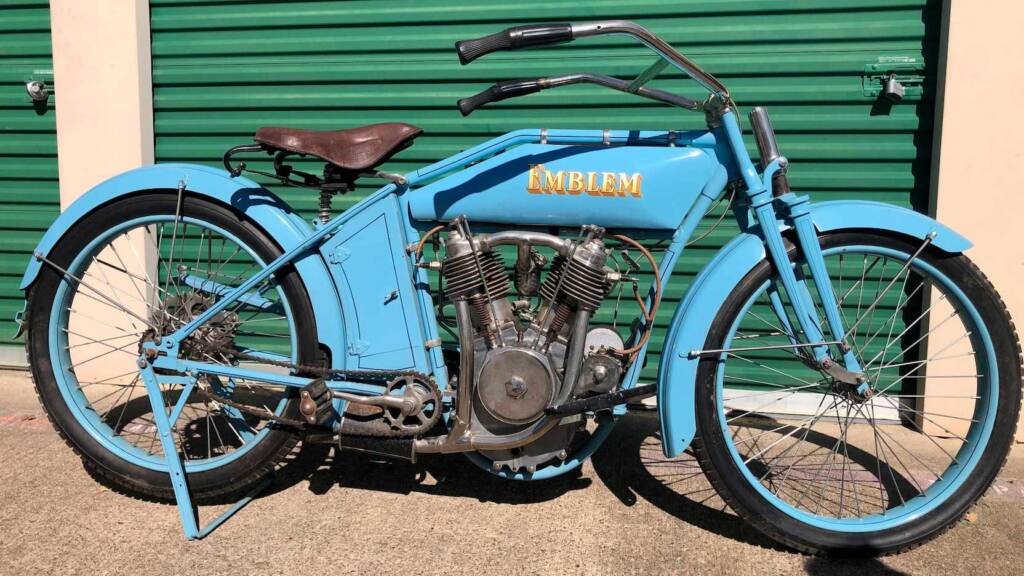
Assembled in Angola, New York, by the Emblem Manufacturing Company from 1907 to 1925, Emblem motorcycles stand as a testament to early 20th-century American craftsmanship and ingenuity. Emblem carved its niche with distinctive designs and innovative features in a period marked by the flourishing of various motorcycle brands.
The initial Emblem motorcycles, mirroring the trend of their time, utilised Aurora-Thor castings for the engine. These early models were strategically placed, occupying the space where much of the seat post resided in a diamond-type bicycle frame. As of 1909, the company began producing its own engines, heralding a shift in manufacturing autonomy.
By 1909, Emblem had transitioned to manufacturing its own engines, signalling a commitment to refining its designs. The new machines found their place in loop frames, employing a belt-driven mechanism. This shift allowed Emblem to exert greater control over its manufacturing process and enhance the overall performance of its motorcycles.
Emblem made a significant stride in 1910 by introducing a V-twin-engined bike. This marked a pivotal moment in the company’s evolution, showcasing its capacity for innovation. By 1913, the displacement of the V-twin engine had reached 76.6 cubic inches (1254 cc), demonstrating Emblem’s dedication to pushing the boundaries of engine design and performance.
Emblem’s reputation transcended national borders, with a considerable portion of its later production reaching European markets. The motorcycles crafted in Angola, New York, earned acclaim on an international scale, attesting to the quality and appeal of Emblem’s designs.
One of Emblem’s noteworthy models from 1910 featured a combined gas and oil tank cleverly fitted around the frame’s top tube. This innovative design contributed to the motorcycle’s aesthetic appeal and showcased Emblem’s commitment to inventive solutions. The bike also boasted a solo saddle, flat steel fenders, spring forks, a contracting band rear brake, and final drive using a leather belt—a comprehensive package of features that set Emblem motorcycles apart.
Excelsior
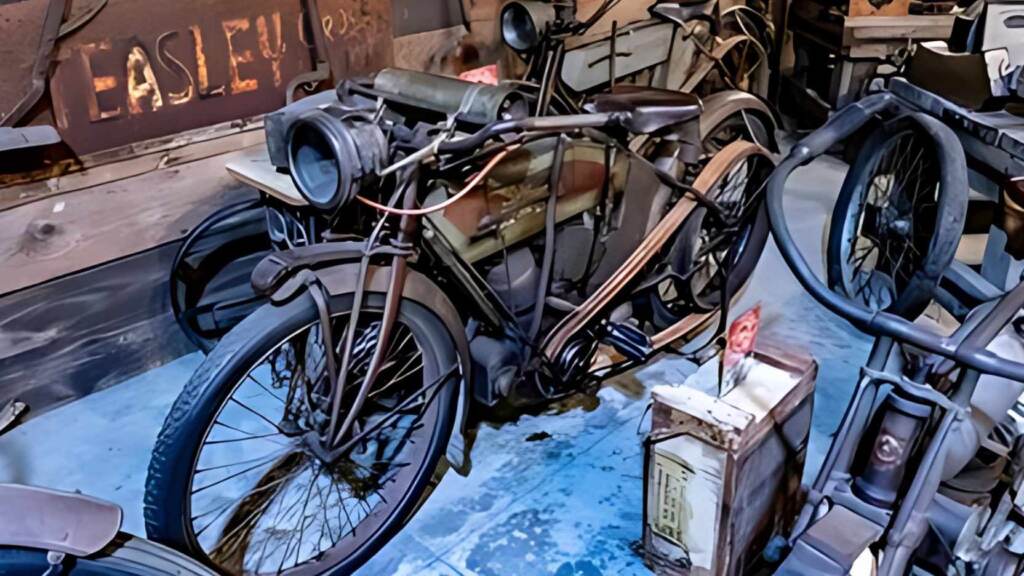
In the vibrant landscape of early 20th-century Chicago, Excelsior diversified into motorcycle production in 1907, laying the foundation for a legacy that would resonate through the annals of motorcycling history. The first machine to roll out of Excelsior’s workshop was a 3.25 horsepower single-belt model, displacing 438.1 cc (26.74 cu in)—a typical representation of the nascent days of internal combustion engine manufacture.
Excelsior’s maiden motorcycle, born in 1907, was a testament to the evolving era of motorised transportation. The 3.25 horsepower single-belt machine embodied the essence of early internal combustion engine craftsmanship. Mounted vertically in a frame derived from a pedal bicycle type, the motorcycle heralded a departure from conventional transportation.
The engine of Excelsior’s inaugural motorcycle featured a vertically mounted design, a configuration reminiscent of the early stages of internal combustion engine development. The mechanically operated exhaust and atmospheric inlet valves were pioneering elements that marked Excelsior as an innovative force in the burgeoning motorcycle industry.
A distinctive feature that set Excelsior motorcycles apart was implementing what became known as the ‘pocket valve’ system. This innovative design incorporated both valves into the engine, showcasing Excelsior’s commitment to efficiency and compact engineering. The atmospheric inlet valve, opened by the vacuum created in the cylinder bore during the piston’s descent on the induction stroke, exemplified the ingenuity of this system.
The vertically mounted engine, coupled with a frame derived from pedal bicycle architecture, reflected Excelsior’s seamless integration of new technologies with existing design principles. This approach facilitated ease of production and hinted at the brand’s commitment to evolving transportation in a manner that resonated with the familiar.
FLANDERS

In the rich tapestry of early motorcycle manufacturing, Flanders emerged as a distinctive marque, albeit briefly. Operational for only three years, from 1911 to 1914, Flanders motorcycles were crafted by the same company known for Flanders cars. The company’s foray into motorcycles began with introducing a four-horsepower single, showcasing a loop frame and belt drive—a hallmark of the era.
Flanders motorcycles first graced the roads in 1911, characterised by a four-horsepower single-cylinder engine. The loop frame, a design choice common in that era, added a touch of elegance to the motorcycle’s appearance. The single-cylinder engine featured a bore and stroke of 3.25 x 3.6 inches, with a displacement of 29.41 cubic inches (483cc). This configuration aligned with the standards of early motorcycle design, where simplicity and functionality took precedence.
The choice of a belt drive mechanism for the four-horsepower single reflected the technological landscape of the time. It was a common feature in early motorcycles, offering a practical solution for power transmission. While modest by contemporary standards, the four-horsepower capacity was formidable in an era when motorcycles were still finding their place on the roads.
In 1914, the company took a bold step by introducing a V-twin model, signalling an ambition to diversify its motorcycle offerings. However, the venture was short-lived, as the same year saw the cessation of production. The V-twin Flanders motorcycles, despite their potential, needed more time to make their mark, and only some were sold before production came to an end.
FLYING MERKEL
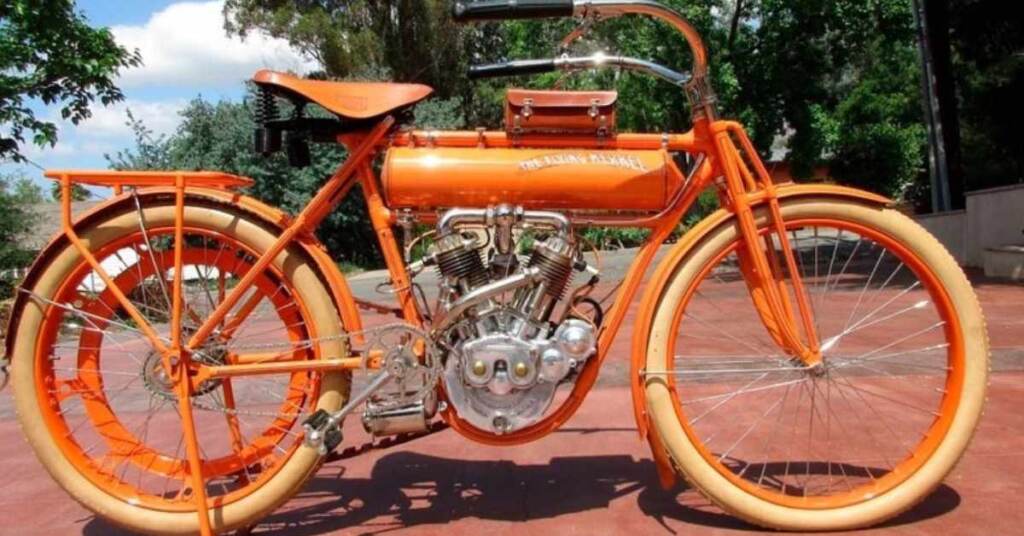
In 1902, the story of Flying Merkel began to unfold when Joseph Merkel ventured into motorcycle manufacturing in Layton Park, Milwaukee, Wisconsin. Armed with his own design of a single-cylinder engine featuring atmospheric intake valves, Merkel embarked on a journey that would leave an indelible mark on the history of American motorcycling.
Joseph Merkel’s foray into motorcycle production initially featured his design of a single-cylinder engine, distinguished by the use of atmospheric intake valves. This innovative approach set Merkel’s creations apart from the crowd. Merkel’s prowess extended to the creation of a V-twin, showcasing his dedication to pushing the boundaries of motorcycle engineering.
Merkel’s contributions weren’t confined to engines alone. In a groundbreaking move, he designed a spring frame, becoming the first U.S. manufacturer to introduce this innovation to the market. The spring frame, a precursor to modern suspension systems, marked Merkel as an industry trailblazer.
In 1909, a pivotal moment in Flying Merkel’s history unfolded as Joseph Merkel’s company merged with the Light Manufacturing and Foundry Company of Pottstown, Pennsylvania. This company was notable for producing Thor-engined machines. Following this merger, the entity was rebranded as the Merkel Light Motor Company, setting the stage for the next phase of the brand’s evolution.
1910 marked a significant transition as motorcycles produced by the Merkel Light Motor Company were rebranded as Flying Merkel. This change in nomenclature heralded a new era for the brand, capturing the imagination of riders with a name that evoked a sense of speed, freedom, and adventure.
HARLEY-DAVIDSON
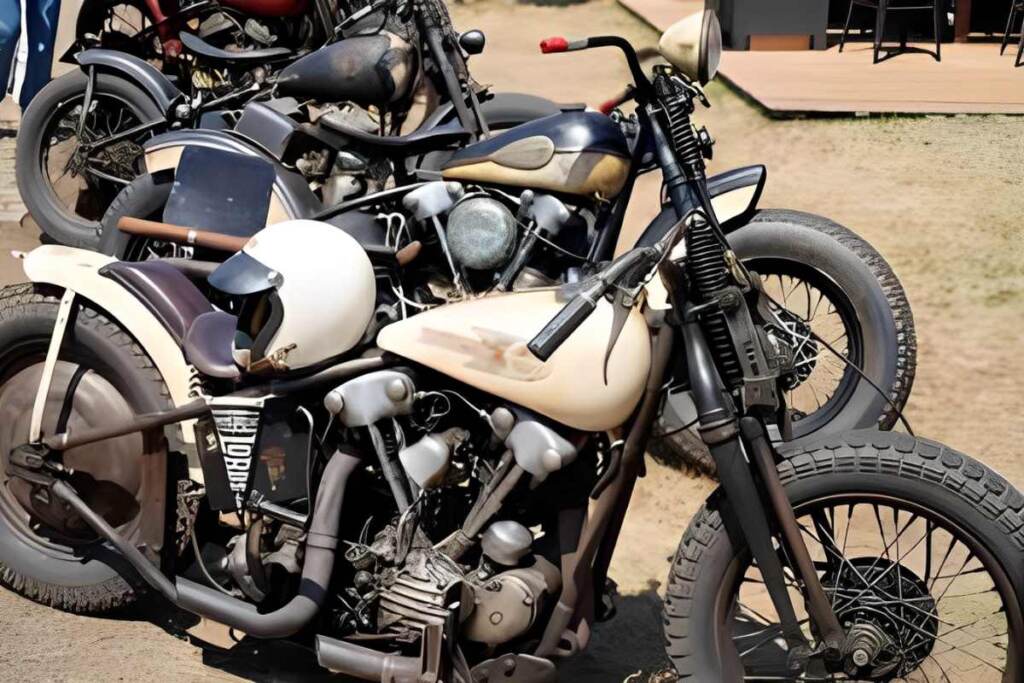
The legendary Harley-Davidson Company, an icon in the motorcycle world, had its humble beginnings in Milwaukee, Wisconsin, in the early 20th century. Founded by William S. Harley and Arthur Davidson, the company later welcomed the Davidson brothers, William and Walter, into its fold. The tenacity and passion of Harley and Davidson set the stage for a legacy that would resonate through the decades.
In the early 1900s, William S. Harley and Arthur Davidson embarked on an ambitious journey, laying the foundation for what would become the Harley-Davidson legend. The duo and the Davidson brothers toiled during evenings and weekends, crafting their earliest machines in a shed in the Davidsons’ backyard—their inaugural factory. In 1903, the fruits of their labour materialised in the form of a single-cylinder motorcycle, displacing approximately 10 cubic inches (160 cc).
The innovation continued to unfold as Harley-Davidson introduced its first V-twin motorcycle in 1909, marking a pivotal moment in the company’s history. The V-twin design proved immensely successful, reaching its zenith in 1911. A chain drive version, particularly notable, achieved substantial sales, with 12,904 units sold in the 1912-1913 period. This success included significant military contracts, with half of the production supplied to the U.S. Army.
Iconic models marked Harley-Davidson’s evolution, each contributing to the brand’s enduring allure. The Model T and J model were popular choices in their respective eras. In 1936, introducing the Knucklehead, with its distinctive engine design, added a new chapter to Harley-Davidson’s storied history. The Knucklehead’s arrival symbolised the brand’s commitment to innovation and pushing the boundaries of motorcycle design.
The Harley-Davidson saga, originating in a backyard shed and a dedication to craftsmanship, became a narrative of resilience, innovation, and a deep connection with the open road. As the company weathered the twists and turns of the 20th century, it not only defined American motorcycling but also established a global legacy that transcends generations. Today, Harley-Davidson stands as more than a brand—it’s a symbol of freedom, individuality, and the enduring spirit of the road.
HENDERSON

Founded in 1911 in Detroit by the Henderson brothers, William G. and Thomas W., Henderson Motorcycles emerged as a notable name in the early 20th-century motorcycle industry. Hailing from an automotive background, with their father manufacturing Henderson Cars, the brothers brought their expertise to the realm of motorcycles.
The Henderson story began with the introduction of an inline four-cylinder engine, ingeniously fitted into what appeared to be an elongated bicycle-type frame. This innovative design, debuting in 1911, set Henderson Motorcycles apart in a rapidly evolving industry. The brothers’ automotive heritage infused a commitment to quality and engineering excellence into their motorcycle venture.
A defining moment for Henderson came in 1913 when a rider named Carl Stevens Clancy embarked on a remarkable journey, covering 18,000 miles (29,000 km) on his Henderson motorcycle. Clancy achieved the extraordinary feat of becoming the first rider to circle the globe on a Henderson. This achievement showcased the durability and reliability of Henderson motorcycles and solidified their place in motorcycle history.
In 1931, a pivotal transition occurred for Henderson Motorcycles as Schwinn, a renowned name in the bicycle industry, took over the company. Under Schwinn’s ownership, the Henderson KJ model gained popularity. The design of the KJ was attributed to Arthur Lemon, adding a touch of modernity to the Henderson lineup.
Henderson motorcycles, with their distinctive design and pioneering spirit, left an enduring legacy in the motorcycle landscape. The brand’s commitment to quality and innovation, coupled with the global journey of Carl Stevens Clancy, contributed to Henderson’s reputation as a symbol of endurance and adventure.
IMPERIAL
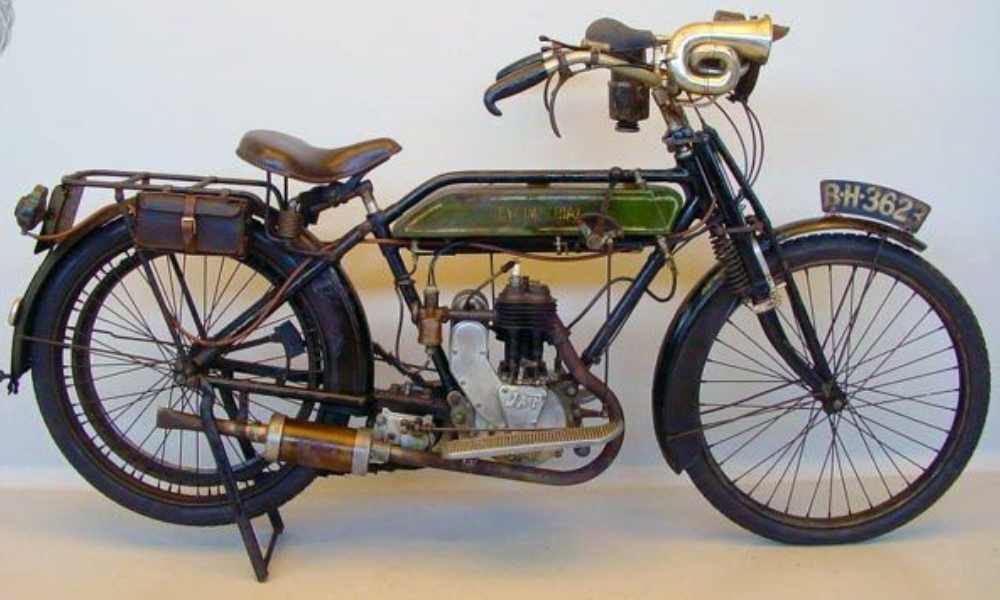
In the vast landscape of motorcycle history, some names flicker like distant stars, leaving us intrigued and curious. One such enigmatic presence is Imperial. While shrouded in mystery, what little is known unveils a tale of craftsmanship and innovation that echoes through the corridors of time.
Imperial motorcycles emerged from the hands of the American Cycle Manufacturing Company around 1902. This company, a versatile player in the realm of pedal bicycles, adorned its products with an array of monikers — American, Cleveland, Columbia, Crescent, Eagle, Monarch, Rambler, and Tribune. Imperial, standing proudly among these, embarked on a journey that would etch its name in the annals of motorcycling history.
While details about Imperial are scant, historical fragments suggest the existence of a single-cylinder motorcycle adorned with a robust 4.5 horsepower engine and a distinctive 90-degree V-twin configuration. This machine, a testament to the engineering prowess of its time, dared to navigate the roads when the motorcycle landscape was still in its nascent stages.
INDIAN
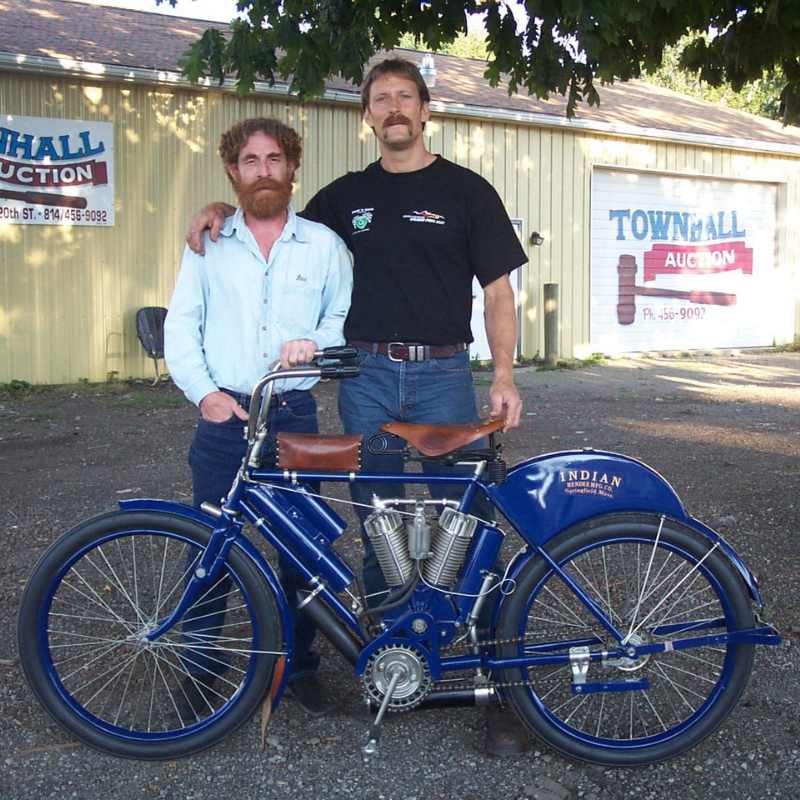
The tale of Indian Motorcycles commences in 1901, a pivotal year that witnessed the collaborative efforts of George Hendee and Oscar Hedstrom. These motorcycle aficionados laid the foundation for Indian Motorcycles in Springfield, Massachusetts. Their inaugural machine, introduced in the same year, showcased a groundbreaking intake-over-exhaust configuration and a total loss lubrication system—an innovation standard in the early motorcycling landscape.
The narrative takes a significant turn with the introduction of the Indian Camelback, a motorcycle that etched a distinctive chapter in the history of two-wheelers. Crafted in a bicycle-style diamond frame, this initial machine featured a single-cylinder engine, a testament to Oscar Hedstrom’s ingenuity. The Camelback’s unique fuel and oil tank configuration, positioned over the rear mudguard, earned it the moniker ‘Camelback.’ This machine, reaching a record speed of 56 mph, showcased innovative design and left an indelible mark on motorcycle evolution.
In 1916, Indian Motorcycles took a significant leap forward by introducing the Indian Powerplus. Having advanced the side-valve concept at Reading Standard, Charles Gustafson brought his expertise to Indian. The Powerplus, with a 997.6 cc engine, marked a powerful evolution for Indian, maintaining its success until 1953. With features like a robust steel loop frame and a top speed of 60 mph, the Powerplus became a symbol of Indian’s commitment to producing powerful and enduring machines.
Recognising the demand for lightweight motorcycles, Indian Motorcycles introduced the 1917 Model O. With a modest 257 cc engine, the Model O addressed the market’s need for small-displacement, efficient machines. Offering a top speed of 45 mph, this lightweight model was a testament to Indian’s ability to diversify and cater to a broader range of riders.
1928 saw the emergence of the Indian Four, a motorcycle that exuded grandeur and innovation. With a 744 cc engine, 80 mph, and 25 bhp top speed, the Indian Four symbolised luxury and performance. Its keystone steel frame added to its aesthetic appeal, making it a marvel in the motorcycle world.
In 1928, Indian Motorcycles unveiled the iconic 101 Scout, a legendary model that would be celebrated for its reliability and racing success. With a 737 cc engine and a top speed of 75 mph, the 101 Scout embodied strength and endurance. Its reputation as one of the best Indian motorcycles ever made endures, symbolising the golden age of motorcycling.
Responding to the discontinuation of the 101 Scout, Indian Motorcycles introduced the Sport Scout in 1935. With a 744 cc engine, a top speed of 80 mph, and 25 bhp, this sports bike filled the void left by its predecessor. The Sport Scout’s European-inspired aesthetics and advanced features made it a standout model, reflecting Indian’s commitment to style and substance.
Venturing into experimental territory, Indian Motorcycles introduced the Indian 841 in 1942, responding to a U.S. government request. With a 750 cc engine and innovative features like a transverse V-twin engine and shaft drive, the 841 represented a departure from convention. While it faced challenges in military adoption, the 841 remains a historical artifact, embodying Indian’s willingness to explore new design avenues. (Image Johnny Gee From Naked Racer )
MILLER
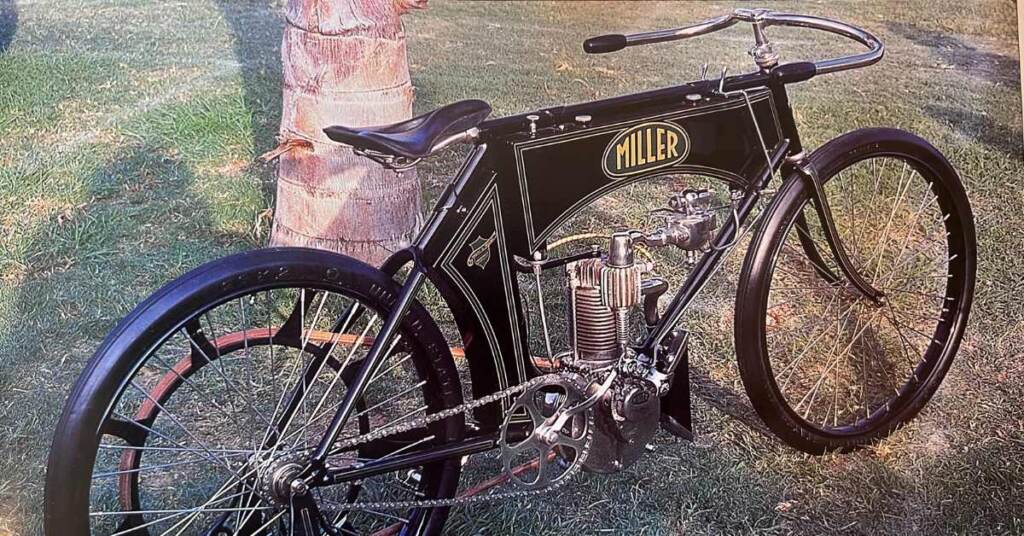
The early 1900s marked a dynamic era in the motorcycle industry, where numerous small companies surfaced, each contributing a verse to the symphony of innovation. In this bustling landscape, Miller Motorcycles entered 1903, embodying the essence of typical early motorcycles.
Like many contemporaries, Miller Motorcycles rolled onto the scene with a design that mirrored the formative years of motorcycling. The heart of this machine throbbed with a single-cylinder engine, a testament to the simplicity and elegance characterising motorcycles in their infancy.
Propelled by the rhythmic hum of a single-cylinder engine, Miller Motorcycles encapsulated the spirit of exploration and adventure that coursed through the veins of early riders. The unmistakable leather drive belt transferred power, creating a symphony of mechanical harmony as the wheels turned and the open road beckoned.
In true early motorcycle fashion, Miller’s creation found its structural identity in a bicycle-type diamond frame. This design, reminiscent of the two-wheeled predecessors, showcased the seamless marriage of cycling and motorcycling. It was a time when innovation was born from the fusion of the familiar with the revolutionary.
The allure of Miller Motorcycles extended beyond its engine’s roar and its wheels’ spin. The oil and fuel tanks, vital lifeblood for the mechanical beast, dangled with purpose. Suspended from the top tube, they became both functional and aesthetic components, adding a touch of rugged elegance to the machine’s profile.
NER-A-CAR
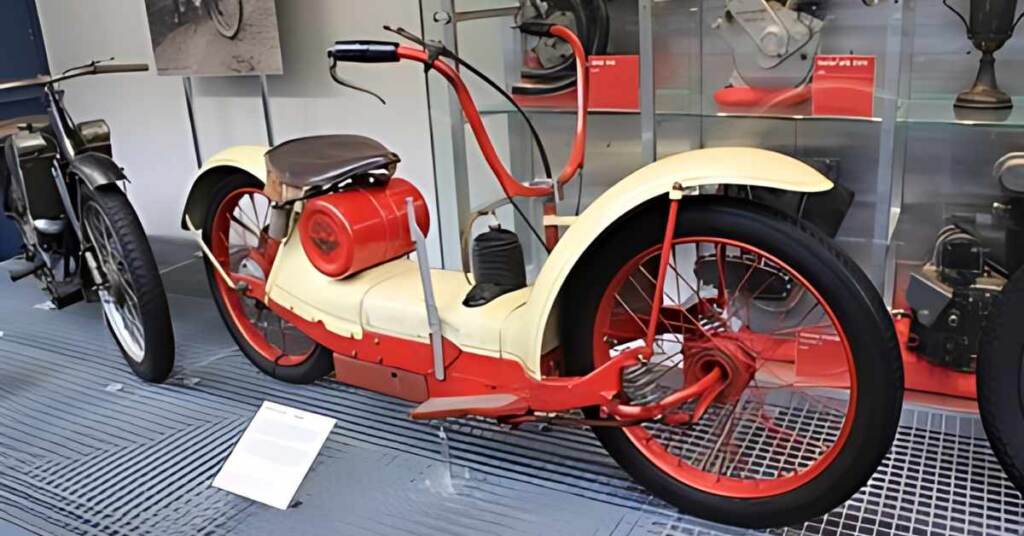
In the dynamic landscape of early 20th-century motorcycling, the Ner-a-Car emerged as a unique and revolutionary creation, bridging the gap between the familiar and the avant-garde. Designed by Carl A. Neracher and first introduced in 1921 in America, the Ner-a-Car redefined conventional motorcycle design with its distinctive features.
At the core of Ner-a-Car’s groundbreaking design was its low-level frame, reminiscent of a car chassis. Crafted from sturdy steel channels, this frame departed from the traditional motorcycle structure, offering a robust foundation akin to automotive engineering.
Powering the Ner-a-Car was a compact yet potent 238cc (14.5 cu in) two-stroke engine. This innovative choice of propulsion set the Ner-a-Car apart, providing riders with an efficient and nimble ride. The rear wheel, driven by the two-stroke engine, delivered a unique riding experience in a market dominated by conventional designs.
Where traditional motorcycles relied on chain or belt drives, the Ner-a-Car took a leap into uncharted territory with its friction drive. This mechanism added to the bike’s distinctive character, offering smooth and quiet operation. It was a testament to Neracher’s willingness to explore new avenues in motorcycle engineering.
The Ner-a-Car story took an interesting turn when production shifted to England. The motorcycle underwent adaptations there, and some models were equipped with 347cc (21.1 cu in) Blackburne side-valve engines. This transatlantic transition not only reflected the global impact of the Ner-a-Car but also showcased its ability to evolve with changing preferences and technological advancements.
PEERLESS
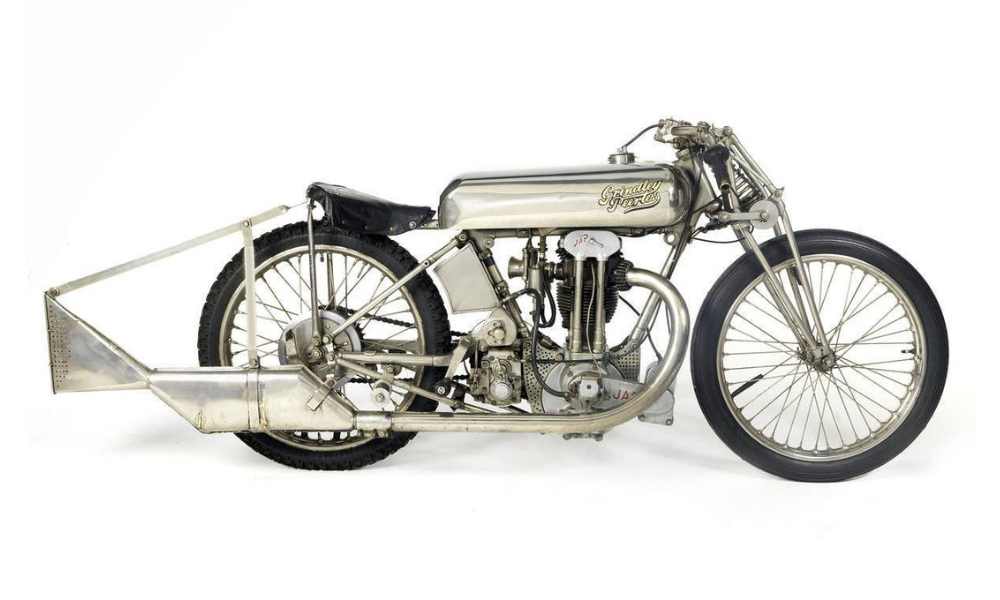
The name “Peerless” in the realm of motorcycles has a fascinating history, with its echo heard in the American landscape and across the British motorcycle scene before the upheaval of World War I. This narrative delves into the unique story of the American Peerless, a company that left an indelible mark in the early 20th century.
The American chapter of Peerless Motorcycles unfolded in Boston, Massachusetts, where the company operated from 1913 to 1916. During this brief yet impactful period, Peerless showcased a commitment to innovation that set it apart from its peers.
Peerless embraced diversity in its engine designs, crafting both single-cylinder and V-twin engines of their own conception. The powerplants were not mere components; they were a testament to the engineering prowess of Peerless. Bosch magneto ignition systems added a touch of sophistication to the machines, ensuring reliable sparks for optimal performance.
The distinctive loop frames became a hallmark of Peerless motorcycles. The 1912 5 hp Peerless, a single-cylinder marvel, embodied this signature style. Its Bosch magneto, a well-engineered clutch, and a strategically positioned gas tank between the frame rails showcased meticulous attention to detail.
Peerless did not shy away from pushing the boundaries of conventional motorcycle design. The company ventured into uncharted territory with experiments in shaft drive, offering an alternative to the traditional chain or belt systems. Additionally, telescopic forks, a feature now commonplace but avant-garde at the time, found their way into the Peerless repertoire.
Though the timeline of Peerless motorcycles was relatively short-lived, its legacy endures. The machines that rolled out of Boston were not just motorcycles; they were statements of American ingenuity and a testament to the spirit of exploration in the burgeoning world of motorcycling.
PIERCE
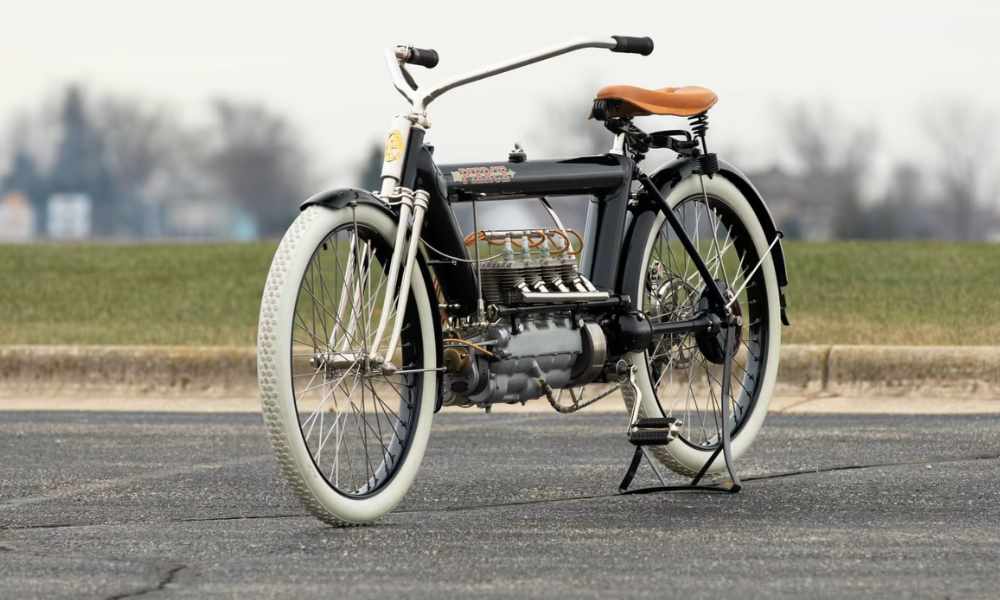
In the annals of motorcycle history, some names stand out not for their longevity but for the indelible mark they leave in a short span. Pierce, a company that operated for four years from 1909 to 1913, is one such luminary. The star in their constellation was the groundbreaking Pierce Four, a motorcycle that reshaped the landscape with innovation and foresight.
At the heart of Pierce’s ephemeral yet impactful existence was the Pierce Four, a marvel that boasted what has been described as a T-head layout. In this innovative design, inverted inlet and exhaust valves flanked the cylinders on either side. This configuration marked a departure from convention, showcasing Pierce’s commitment to pushing the boundaries of motorcycle engineering.
The Pierce Four etched its name in the history books as the first successful shaft-drive motorcycle to be sold in the United States. The adoption of shaft drive was revolutionary, offering riders a smoother and more reliable alternative to chain or belt-driven systems prevalent during that era. Pierce wasn’t just building motorcycles; they were crafting a new chapter in the evolution of two-wheelers.
The journey of the Pierce Four was one of continuous refinement. While the initial iterations did not feature a clutch, later versions incorporated this essential component, enhancing the overall riding experience. Furthermore, adding a two-speed transmission underscored Pierce’s commitment to providing riders with versatility and control over their machines.
POPE

In the early 20th century, the roar of engines echoed alongside the hum of progress, and one name that resonated in the nascent motorcycle industry was Pope. Founded by the visionary Colonel Albert A. Pope, the company not only crafted motorcycles but also left an indelible mark on the annals of innovation between 1911 and 1918.
At the helm of Pope Motorcycles was Colonel Albert A. Pope, a polymath known for his forays into automobiles and bicycles. His venture into motorcycles was marked by a commitment to excellence and a thirst for innovation. The company’s motorcycles, birthed from this spirit, showcased a blend of power and ingenuity.
Pope Motorcycles commenced their journey with a 426cc single-cylinder engine. This powerhouse set the stage for the brand’s ascent in the motorcycle realm. As the wheels of progress turned, Pope diversified its offerings, introducing V-twins and singles, each a testament to the evolving landscape of two-wheeled marvels.
Among Pope’s notable creations, the 1913 L model is unique – the U.S. Post Office immortalized it. This 1000cc capacity, four-stroke wonder captured the attention of riders but also the imagination of the nation. Its prowess and distinctive design made it a symbol of excellence, earning a place in the historical tapestry of American motorcycles.
READING STANDARD

In the Classic American motorcycle history, Reading Standard is a symbol of innovation and pioneering spirit. Flourishing in its Reading, Pennsylvania factory during the first decade of the 20th century, Reading Standard left an indelible mark on the industry.
The journey of Reading Standard began with machines powered by Thor engines, echoing a design not dissimilar to contemporary Indians. These early motorcycles laid the foundation for Reading Standard’s foray into the diverse world of two-wheelers. Both singles and V-twins, boasting engine capacities of 990cc and 1170cc (60.4 and 71.4 cu in), rolled out of their factory, setting the stage for a captivating decade of production.
In 1907, Reading Standard etched its name in the history books by becoming the first U.S. manufacturer to build motorcycles with side-valve engines. This pioneering move showcased the company’s commitment to pushing the boundaries of engineering. Charles Gustafson, the mind behind these sidevalve engines, would later join Indian, where he played a pivotal role in designing the iconic Powerplus engine.
Reading Standard didn’t just produce motorcycles; it etched its name in adventure and triumph. In 1908, the company proudly claimed the title of the first to produce the only real mechanical intake valve-equipped motorcycle in the United States. To add to its laurels, Reading Standard boasted that its machine was the sole motorcycle to conquer the challenging Pike’s Peak in Colorado, a testament to the rugged reliability of their creations.
The Reading Standard factory wasn’t just a production hub but a breeding ground for race bikes destined for professional riders. As the brand embraced the thrill of the racetrack, it further solidified its reputation as a force to be reckoned with in the competitive arena of motorcycle racing. These race bikes embodied Reading Standard’s commitment to performance and innovation.
Reading Standard’s legacy extends beyond its production years. The influence of its early innovations, particularly in side-valve engines, reverberated through the industry. The shift in design paradigms and the triumph at Pike’s Peak showcased the capability of Reading Standard motorcycles and the spirit of adventure and excellence that defined the brand.
SEARS
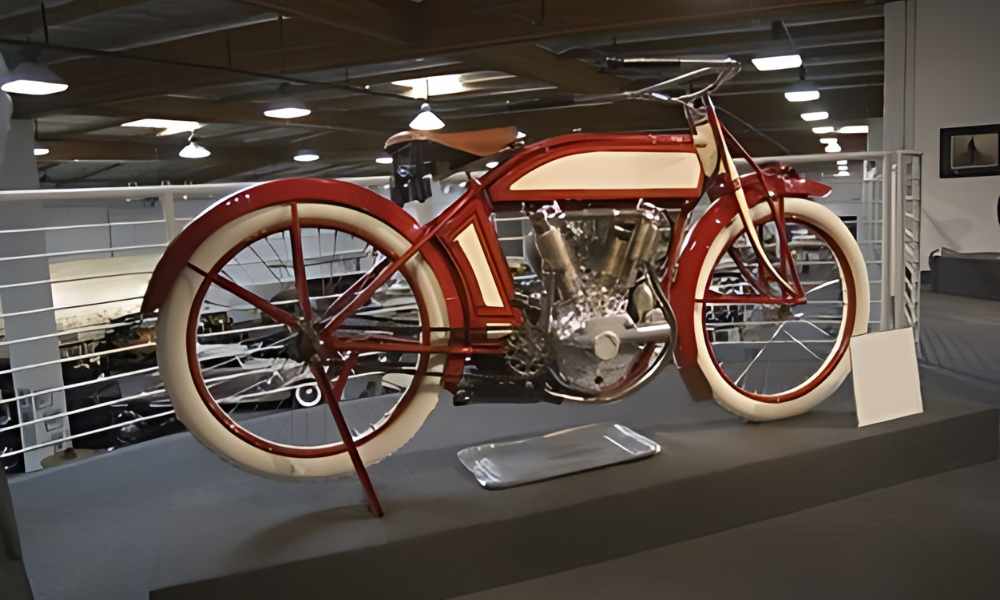
Sears, Roebuck & Co., the iconic Chicago-based department store, left an indelible mark on American retail history. Lesser known is its foray into the world of motorcycles. At different points in its illustrious history, Sears offered motorcycles branded under its name, creating a unique chapter in the story of both retail and motorcycling.
In the early decades of the 20th century, specifically in 1910, Sears ventured into the motorcycle market. The company, synonymous with catalogue shopping, included single-cylinder machines in its offerings. These motorcycles, adorned with the Sears brand, found a place in the hearts of enthusiasts browsing the Sears catalogue, marking the retail giant’s initial foray into the world of two-wheelers.
Sears didn’t stop at singles; it also made V-twin engines available to its customers. This diverse lineup, featuring both single-cylinder machines and the more potent V-twins, catered to a broad spectrum of riders. The motorcycles offered by Sears during this era were a distinctive addition to the catalogue, allowing customers to own a Sears-branded machine.
As with many aspects of the motorcycle industry during the early 20th century, Sears’ venture into motorcycles changed. In 1916, Sears discontinued the single-cylinder machines and the V-twin engines from its catalogue. This marked a shift in the retail giant’s engagement with the motorcycle market, aligning with the industry’s dynamic nature during that period.
The Sears motorcycle story continued with its early American offerings. Later in its history, Sears took a global approach, selling motorcycles manufactured by Austrian company Puch and Italian brand Gileras under the Sears and Allstate brands. This shift in strategy reflected Sears’ adaptability to changing market dynamics and its willingness to explore partnerships beyond national borders.
In the post-World War II era, Sears focused on lighter motorcycles and scooters. The Allstate brand continued to be associated with these smaller, more nimble machines. However, the motorcycle chapter in Sears’ history eventually came to a close in 1968 when it ceased its sales of motorcycles.
Traub

Discovered hidden within a bricked-up wall in a Chicago suburb four decades ago, the 1916 Traub motorcycle remains a mystery, shrouded in secrecy and intrigue. Rescued from its clandestine sanctuary after 50 years, this singular Traub is the only known example. Despite efforts to unveil its secrets, it has left enthusiasts with more questions than answers. What is certain, however, is that this motorcycle is a rare and unparalleled classic, now residing in the renowned Wheels Through Time classic motorcycle museum in Maggie Valley, N.C.
The tale of the 1916 Traub begins with a discovery that captured the imagination of motorcycle enthusiasts worldwide. Found concealed in a wall, its existence for half a century only added to the allure surrounding this enigmatic machine. Its hiding circumstances and reasons remain a mystery, fueling speculation and fascination.
The 1916 Traub, the only one of its kind, was meticulously handcrafted, showcasing a level of craftsmanship far ahead of its time. What sets it apart is the twin-brake/single-cam system, a feature unique among American motorcycles. This innovation underscores the motorcycle’s visionary design, defying the norms of its era.
At the heart of the 1916 Traub beats an 80-cubic inch V-twin engine, boasting a remarkable capacity of 1,278cc. This was a substantial leap forward compared to the 500- 745cc accommodations typical of motorcycles during that period. The technological prowess of the Traub was not merely confined to its engine; it featured a twin-brake/single-cam system, showcasing engineering ingenuity that was unparalleled in its time.
The 1916 Traub wasn’t just a marvel in design; it was a powerhouse on the road. With the ability to reach speeds of 85 mph, it left its contemporaries in the dust. This exceptional speed capability and its distinctive design established the Traub as a trailblazer, even in the context of the rapidly evolving motorcycle landscape of the early 20th century.
Despite the relentless pursuit to unveil the true identity of the 1916 Traub, the motorcycle continues to guard its secrets. Attempts to unravel its history have led to frustrating dead ends, adding to its mystique. For now, enthusiasts must content themselves with the hard facts gleaned by its current custodian, the world-renowned Wheels Through Time classic motorcycle museum.
The 1916 Traub remains an enigma, a one-of-a-kind classic American motorcycle that defies easy categorisation. Its discovery, design, and performance continue to captivate, making it an enduring legend in the world of motorcycles—a mystery that may never be fully solved.
THOR
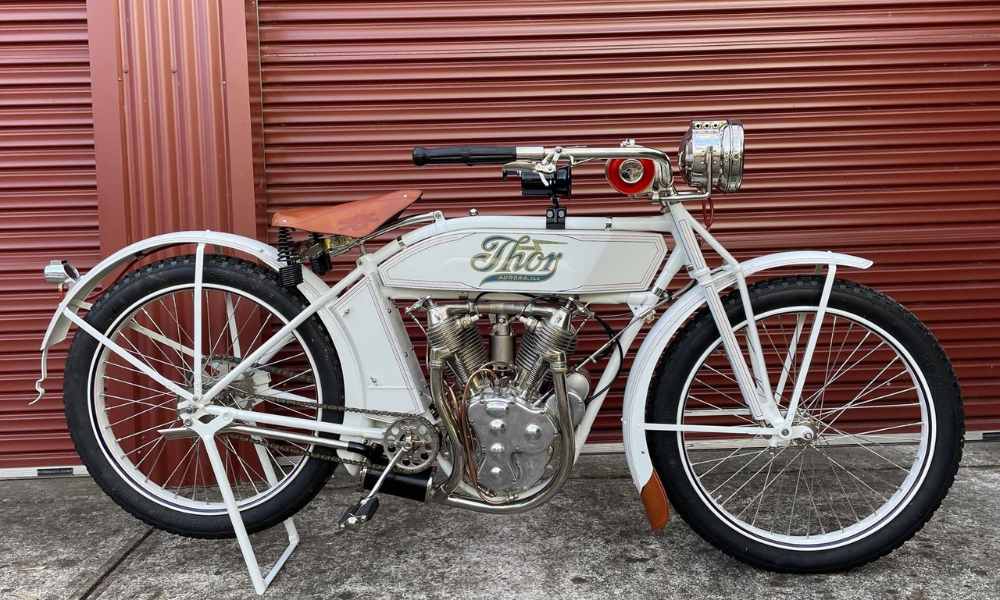
The Thor brand, hailing from the United States, was the creation of the Aurora Automobile Machine Company. This company played a unique role in the early 20th-century motorcycle landscape, particularly due to its association with the legendary Oscar Hedstrom of Indian Motorcycle fame. The Thor motorcycles, produced between 1907 and 1919, emerged as a testament to engineering prowess and innovation.
The story of Thor is intertwined with the expertise of Oscar Hedstrom, the mastermind behind Indian Motorcycles. The Aurora Automobile Machine Company, leveraging Hedstrom’s design brilliance, manufactured engine castings for the Springfield marque, a noteworthy player in the early motorcycle scene. This collaboration laid the foundation for Thor motorcycles and marked the brand’s entry into complete motorcycle manufacturing.
Thor motorcycles were characterized by their diverse lineup, featuring both single-cylinder and V-twin models. This versatility allowed Thor to cater to a broad spectrum of riders, reflecting the company’s commitment to meeting the varied demands of the emerging motorcycle market.
One standout model in the Thor lineup was the 1915 V-twin, known as the Model U. This particular model was rated at an impressive 12 horsepower, showcasing Thor’s dedication to delivering motorcycles with substantial power and performance. The Model U became a representation of Thor’s commitment to innovation and excellence during this era.
Whizzer
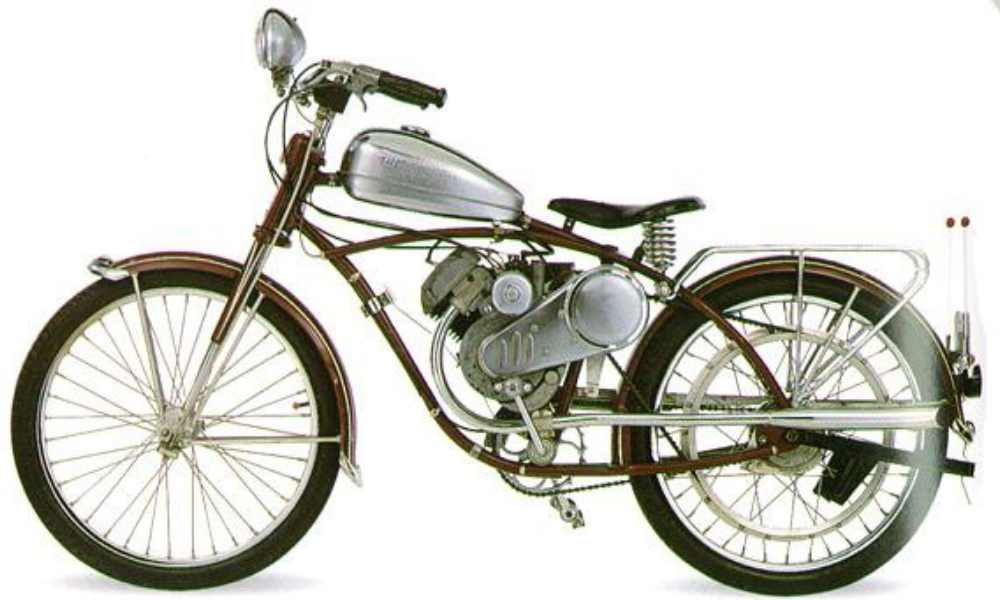
Whizzer bicycle engines, a distinctive line of motorised bicycle engines, graced the roads of the United States from 1939 to 1965, creating a unique blend of pedalling and motorised power. These engines, often sold as kits, allowed enthusiasts to transform their bicycles into efficient and economical motorised rides.
The Whizzer bicycle engine story began in 1939 when Breene-Taylor Engineering, a Los Angeles-based manufacturer specialising in aeroplane parts, ventured into the world of motorised bicycles. The engine, initially produced, was an air-cooled, four-cylinder marvel with 8.45 cubic inches of displacement, developing 1 3/8 horsepower. While not known for exceptional durability, it set the stage for a new era of personal transportation.
The Whizzer engine, with its distinctive features, reflected the engineering trends of its time. Boasting a two-piece split crankcase, roller main, and rod bearings, pressure lubrication, a counter-weighted drop-forged steel crankshaft and connecting rod, and a 6.5:1 compression ratio showcased a commitment to quality and innovation. The bore and stroke, a constant at 2 1/4″ x 2 1/8″, laid the foundation for the following Whizzer motors.
By 1942, despite its initial promise, Whizzer engine sales faced challenges, with only about 2500 units sold. Recognising the need for a fresh approach, the Whizzer operation changed ownership. Dietrich Kohlsatt and Martin Goldman took the reins, injecting new life into the venture and steering it towards a more successful trajectory.
YALE
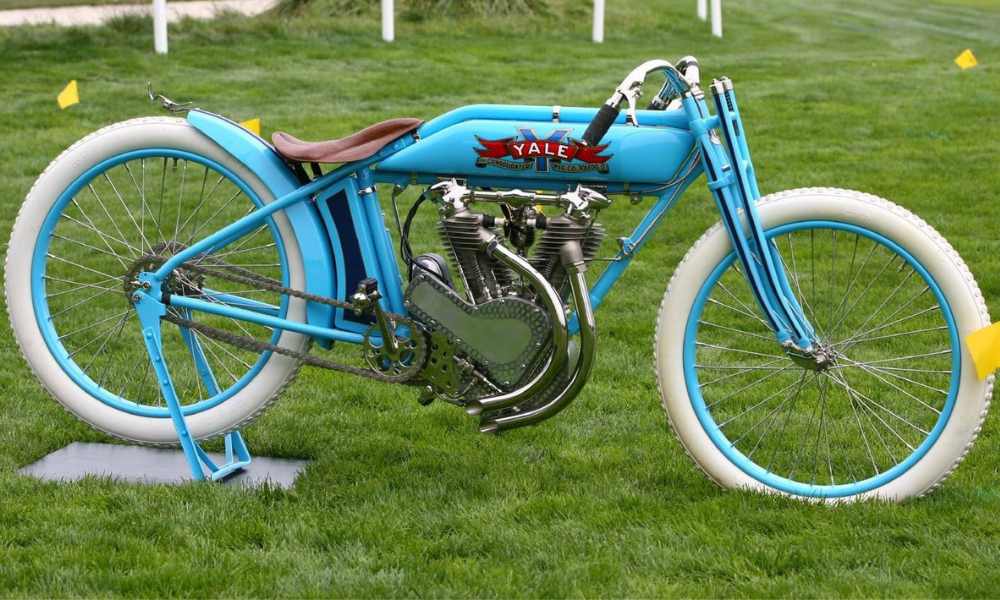
The Consolidated Manufacturing Company, based in Toledo, Ohio, made a significant mark on the early motorcycle scene when it acquired the California-based company Yale. This acquisition paved the way for producing motorcycles that blended innovation and performance, contributing to the evolving narrative of American motorcycling in the early 20th century.
The year 1902 marked the beginning of Yale motorcycles under the umbrella of the Consolidated Manufacturing Company. With an initial focus on both single-cylinder and V-twin designs, Yale entered the motorcycle arena with a pioneering spirit, ready to explore the possibilities of two-wheeled transportation.
In 1910, Yale introduced a single-cylinder motorcycle that showcased technological advancements for its time. The 500cc (30.5 cu in) displacement and features like an atmospheric inlet valve and battery and coil ignition demonstrated Yale’s commitment to engineering motorcycles with both efficiency and innovation in mind. This single-cylinder model provided a reliable and efficient riding experience and reflected the era’s technological ethos.
The same year, Yale unveiled a 45-degree V-twin of its own design, adding a potent and stylish option to its lineup. The V-twin configuration, known for its balance and power delivery, became popular among riders seeking enhanced performance. Yale’s foray into designing its own V-twin showcased the company’s ambition to offer a diverse range of motorcycles to cater to different rider preferences.
Despite their early success and innovative designs, Yale motorcycles ceased production in 1915. The dynamics of the motorcycle industry during this period, influenced by factors such as competition, market trends, and economic conditions, likely played a role in the decision to conclude production.
The allure of American classic motorcycles lies in their rich history, unique designs, and cultural impact. These timeless machines continue to captivate enthusiasts, bridging the past and present.
The collectors’ market for American classic motorcycles remains robust, fueled by the passion and enthusiasm of those who appreciate the artistry and craftsmanship of these iconic bikes.
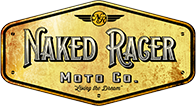
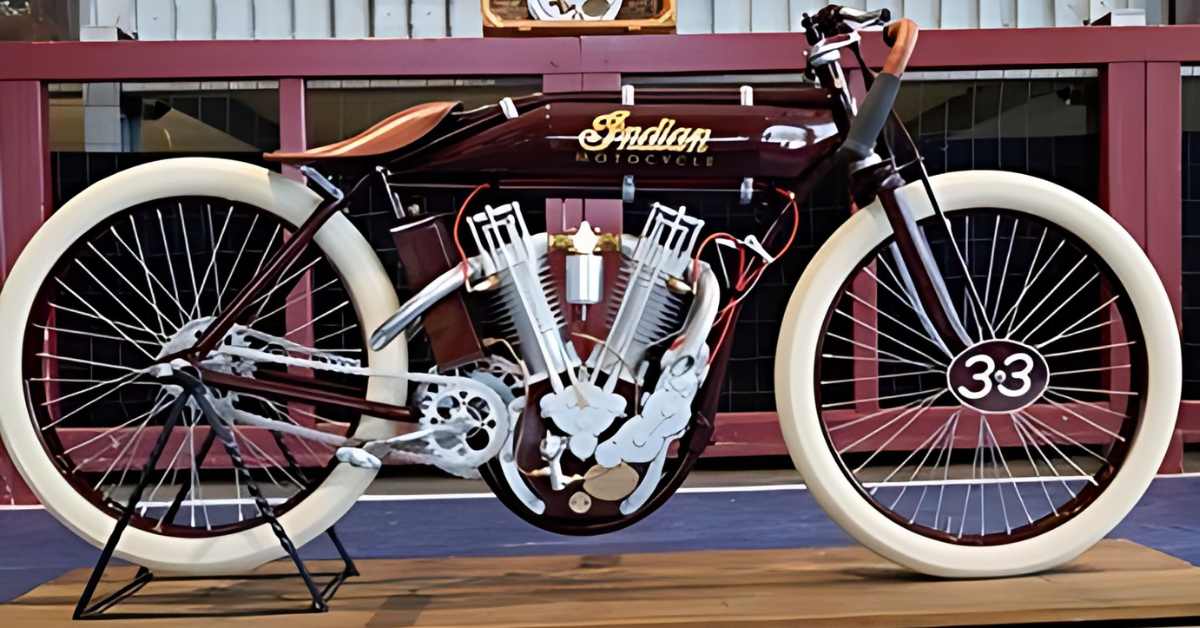
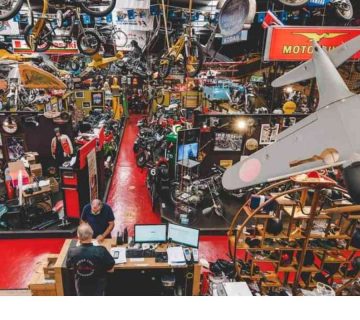
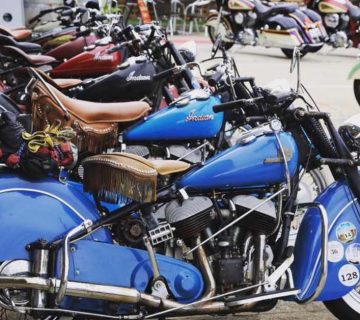

No comment